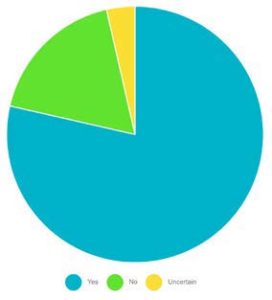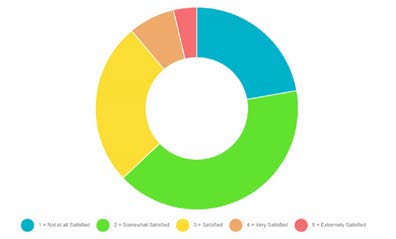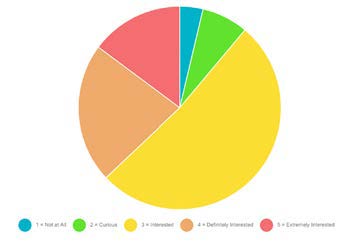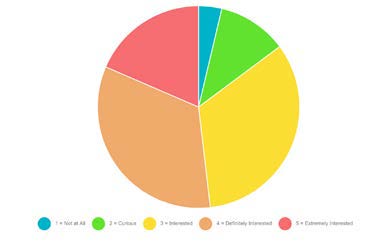ASSOCIATION NEWS: CFA Health and Safety Survey Says…
CFA conducted a survey on the state of safety education in member companies. The survey was the precursor for work being undertaken to develop a learning management system (LMS) and offer online courses for access by members of the Association, to bring better education to the workforce. Such an LMS not only elevates the quality of the education, but it also efficiently assigns, monitors and maintains a quality safety education program that can become the cornerstone of risk management.
This survey, released at the start of May, was submitted to all members of the Concrete Foundations Association to gather input on the types of and commitment to safety education throughout the membership. The brief survey consisted of eleven total questions and has provided valuable data regarding both the current state of safety education found in CFA member companies, and the interest and need for improvement in this area.
It is not surprising to hear companies talk of the challenges they face weekly or monthly to engage the work force in safety education. Relying on toolbox talks from a recognized industry provider or insurance company can deliver meaningful content, though not often 100% pertinent to the duties and specifics of this industry. Safety training is admittedly most often OTJ, informal and offered, in many companies, as needed. Martin Glenday, president of Moxie Media, Inc., the leading safety education LMS in the market today, maintains that, “Across all industries, not just in construction, we see companies every day involved in reactive or defensive safety education, rather than proactive education. This means they wait to do training only until after an issue or an accident, when it is too late. Safety training should be done year-round and for every dollar spent, companies get several dollars in benefits. The average accident requiring medical attention can cost $37,000, according to the National Safety Council. We have found that the best, most efficient way to provide health and safety training is online, with the aid of an LMS system to keep track of students.”
Arthur J. Gallagher, broker for CFA’s Core360 insurance program, agrees with Glenday’s assessment. Working with program manager for Gallagher, Kristen Long, the CFA Board has come to know that while reactive or defensive safety education is the norm, it should be the last resort. When an issue arises, the injury has already been done to the worker and there is a negative impact both on workforce and on the company mod rating. It is often very difficult to recover from these physical, emotional and financial costs in any reasonable time frame, and it takes great energy to turn around.
Therefore, CFA’s Board of Directors and management staff began considering an education system that could simplify and improve health and safety training with a cost-effective approach. With the data gathered from the survey, CFA could begin finalizing the details on a program that would be suitable to all CFA members, no matter their size. Daniel Guttman of Business Management Solutions, Inc., a Moxie collaborator, describes it as preemptive safety education. He says, “Safety education can be defined in many ways and each company has their own take and preference. But there is little argument that a good safety program benefits every employee and each CFA company member.”
As each question is summarized, you are invited to compare your own response to challenge your background and understanding for the issue, and perhaps broaden your own perceptions of what you may be achieving now as compared to where you might like to go next. See if you agree with the CFA that such a robust Health and Safety Program can be beneficial to your needs.
Q1: Does your company have an organized safety program?
Nearly 80% of respondents affirmed they have an organized safety program. This was left open to the individual as to what the definition of “organized” was and can be understood to mean many different structures across the industry.
Q2: How satisfied are you regarding your safety program?
The responses to this question begin to show that despite the overwhelming majority identifying that an organized approach to safety exists, the comfort level or satisfaction with such an approach is lacking. More than 60% of the respondents’ lack confidence in existing methods
Q3: What methods do you use to conduct safety training?
The respondents demonstrated through this question that almost half of the companies handle this one-on-one and/or reactively (after an incident occurs). This question was left open for multiple responses, recognizing that companies may have more than one standard position or varied responses based on the situation. It is a positive sign that a framework exists for more than half the companies responding. Such a framework can form the nucleus of a successful transition to an enhanced safety education program that reaches into the workforce more effectively as well as the entire company. Roughly half of the respondents also indicate experience and comfort in using videos for the basis of such learning.
Q4: What specific products or sources do you use for the safety training identified by Q3?
Building off the previous question, the goal was to determine if there are consistencies or at least repetition in the resources currently being used for the current education. Some of the responses indicated an insurance company provided content. Most concerning from these responses, however, was the number that responded with a focus on these resources related to orientation of new hires rather than an established, on-going component to the company culture.
Q5: Do you use any type of e-learning or Learning Management System (LMS) for your safety program?
Here is where new technology or delivery platforms within our industry is required, as 85% of the respondents indicated they do not use online courses to deliver their safety programming. An LMS organizes, schedules, tracks and even delivers the safety education in a group setting or on an individual basis, depending on how the company chooses to implement the system. This will be the foundation for educating CFA members as the program develops, and a larger cross-section of the industry will be invited to consider the benefits of such a program.
Q6: Thinking of your response to Q5, what types of systems are you currently using?
Of the responses received to this expansion thought, none of the responses were evidence of actual LMS. None of the respondents provided recognition of a web-based or other technology-based system for delivering consistent safety education.
Q7: Do you have a systematic way to track and organize your safety training?
This question was asked to challenge the thinking of an LMS as it relates to company culture and personnel management. A near even split resulted between those that consider their in-house system adequate, or at least systematic, and those that do not.
Q8: If CFA offered an e-learning tool (LMS), would you be interested in learning more about it and consider using it?
This is an obvious question the respondents should have expected when moving through a survey about their current experience. As established in the introduction to the survey, the purpose was to develop a sufficient background to determine whether this direction for the Association would be meaningful opportunity for the membership and for other industry leaders. This is a question that also asks, in a way, “Are you willing to consider changing your approach?” The results were not just supportive of the present development by the Board, but overwhelmingly in favor of continuing the effort and expediting the opportunity. Nearly 90% of respondents affirm interest at varying degrees.
Q9: If the CFA offered a program to help track and organize your current and future safety training, would you be interested in learning more about it and consider using it?
While this question is like the previous question, it was offered in this way to establish interest in a new CFA educational program. As you can see, the clear majority of respondents (82%) indicated they were interested or very interested in a prospective safety education program.
Q10: How many work-hours per week or month are currently being used to manage your company’s safety program?
Indicating the costs associated with current management or organizational practices, this question was open-ended and text-based to collect the broad range of responses and respondents’ thoughts. The hope was to identify any consistencies in how fractionally small the attention to safety education is for the company, or how labor-intensive and time-consuming they actually are. Either end of the spectrum might be seen to derive further value in becoming involved with an LMS. Responses ranged from “We are not doing much right now” or “Less than an hour per week,” to “20-30 hours per month” and “30 hours per week.” One respondent contributed, “6 or less…not enough.” After reading this article, we hope you agree that despite the best intentions, most companies do not devote enough effort to safety training.
Q11: How much would you be willing to pay annually, per employee, for a system that would: Provide quality e-learning safety courses, allow you to deliver your own internal training content, assign courses based on employee position, track both e-learning and classroom training, and deliver reports on which employees are complying and those who are past due?
This question analyzes how much value companies would might assign, in terms of money to a more intentional or structured safety education program. The CFA board has been discussing the direction of safety education and specific LMS opportunities. Their goal is to develop a program that maximizes the benefits while minimizing the costs and efforts at implementation. This question asked for the perceived value of training at a cost of $25, $50, $100, $200 and $300 per employee and offered an open-ended text option. It seems the yearly range of $50-200 per employee, cited by over 50% of the respondents, was a target for many companies. This will be further evaluated as we bring forward information on the system that the CFA plans to develop and implement.

















